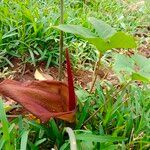Underground part a short, tuberous rhizome, subglobose or subcylindric, producing few annual offsets or splitting up. Petiole green or variously flushed with purple, 25-40 cm; leaf blade cordate-ovate in outline, usually deeply 3-lobed, rarely 5-lobed; central lobe ovate, 10-15 × 6-11 cm, acuminate, sometimes mucronate; lateral lobes 8-13 cm. Inflorescence appearing after leaves; peduncle 5-10 cm, elongating in fruit. Spathe convolute at base, outside green, inside green, to 30 cm, ovoid or ellipsoid, 2.5-3.5 × 1-1.5 cm, constricted at apex; limb spreading, outside green, inside dark purple to reddish purple, ovate-lanceolate, ca. 15 × 5-8 cm, apex acuminate. Spadix shorter than spathe; female zone slightly conic, 7-10 mm; ovary yellowish green; stigma sessile, dark or mid-purple, disciform; sterile zone 2-3 cm, proximal half densely covered with staminodes, distal half naked; staminodes strongly curled but mostly directed downward and covering most of female zone, filiform, 7-12 mm; male zone 1.5-2 cm; stamens pink; appendix shortly stipitate, glossy purple or reddish, narrowly conic, 5-12 cm × 4-7 mm, base truncate, apex acute or subacute. Fruiting zone with spathe remaining; berries at first green with purple spots, white when mature, ellipsoid, 1-or 2-seeded. Fl. May-Jul.
More
A fleshy annual herb. It grows 30-50 cm high. It grows from an underground tuber. This is several cm across. The leaf stalks are 40 cm long. The leaves are arrow shaped. They have 3 lobes. The leaves are 20 cm long by 10 cm wide. The flowers are reddish. They are in a spike. It has a large, brown spathe. The fruit is a green berry with purple spots. There are 1-2 seeds.

